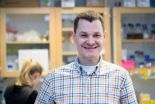(Press-News.org) Biologists have long considered cells to function like self-cleaning ovens, chewing up and recycling their own worn out parts as needed. But a new study challenges that basic principle, showing that some nerve cells found in the eye pass off their old energy-producing factories to neighboring support cells to be "eaten." The find, which may bear on the roots of glaucoma, also has implications for Parkinson's, Alzheimer's, amyotrophic lateral sclerosis (ALS) and other diseases that involve a buildup of "garbage" in brain cells.
The study was led by Nicholas Marsh-Armstrong, Ph.D., a research scientist at the Kennedy Krieger Institute and an associate professor in the Johns Hopkins University School of Medicine's Solomon H. Snyder Department of Neuroscience, together with Mark H. Ellisman, Ph.D., a neuroscience professor at the University of California, San Diego. In a previous study, the two had seen hints that retinal ganglion cells, which transmit visual information from the eye to the brain, might be handing off bits of themselves to astrocytes, cells that surround and support the eye's signal-transmitting neurons. They appeared to pass them to astrocytes at the optic nerve head, the beginning of the long tendril that connects retinal ganglion cells from the eye to the brain. Specifically, they suspected that the neuronal bits being passed on were mitochondria, which are known as the powerhouses of the cell.
To find out whether this was really the case, Marsh-Armstrong's research group genetically modified mice so that they produced indicators that glowed in the presence of chewed up mitochondria. Ellisman's group then used cutting-edge electron microscopy to reconstruct 3-D images of what was happening at the optic nerve head. The researchers saw that astrocytes were, indeed, breaking down large numbers of mitochondria from neighboring retinal ganglion cells.
"This was a very surprising study for us, because the findings go against the common understanding that each cell takes care of its own trash," says Marsh-Armstrong. It is particularly interesting that the newly discovered process occurs at the optic nerve head, he notes, as that is the site thought to be at fault in glaucoma. He plans to investigate whether the mitochondria disposal process is relevant to this disease, the second leading cause of blindness worldwide.
But the implications of the results go beyond the optic nerve head, Marsh-Armstrong says, as a buildup of "garbage" inside cells causes neurodegenerative diseases such as Parkinson's, Alzheirmer's and ALS. "By showing that this type of alternative disposal happens, we've opened up the door for others to investigate whether similar processes might be happening with other cell types and cellular parts other than mitochondria," he says.
INFORMATION:
Link to the PNAS paper: http://www.pnas.org/content/early/2014/06/11/1404651111.abstract
UCSD press release: http://health.ucsd.edu/news/releases/Pages/2014-06-16-getting-rid-of-mitochondria.aspx
Neurons get their neighbors to take out their trash
Some cells in the retina pass off worn out parts to supporting cells for disposal
2014-06-19
ELSE PRESS RELEASES FROM THIS DATE:
Emerging HIV epidemics among people who inject drugs in the Middle East and North Africa
2014-06-19
DOHA, QATAR (June 17, 2014) -- HIV epidemics are emerging among people who inject drugs in several countries in the Middle East and North Africa. Though HIV infection levels were historically very low in the Middle East and North Africa, substantial levels of HIV transmission and emerging HIV epidemics have been documented among people who inject drugs in at least one-third of the countries of this region, according to findings published today in PLOS Medicine.
The HIV epidemics among people who inject drugs (PWID) are recent overall, starting largely around 2003 and ...
Possible new combination treatment for cancer
2014-06-19
A few years ago, a molecule known as "JQ1" was developed, which can block so called BET bromodomain proteins. This switch off the known cancer gene MYC thereby preventing cancer cells from dividing.
The discovery was regarded as a major breakthrough. A problem was that JQ1 did not function optimally in animal experiments, and this means that it has not been possible to test the treatment on cancer patients.
New molecule
Jonas Nilsson and his research group have developed, in collaboration with the Canadian company Zenith epigenetics, a new molecule known as "RVX2135", ...
Long-term follow-up after bariatric surgery shows greater rate of diabetes remission
2014-06-19
In a study that included long-term follow-up of obese patients with type 2 diabetes, bariatric surgery was associated with more frequent diabetes remission and fewer complications than patients who received usual care, according to a study in the June 11 issue of JAMA, a diabetes theme issue.
Obesity and diabetes have reached epidemic proportions and constitute major health and economic burdens. Worldwide, 347 million adults are estimated to live with diabetes and half of them are undiagnosed.
Studies show that type 2 diabetes is preventable. The incidence of diabetes ...
New cocaine tracking system could lead to better drug enforcement
2014-06-19
Law enforcement authorities need to better understand trafficking patterns of cocaine in the United States to address one of the world's largest illegal drug markets, according to a Michigan State University researcher whose new methodology might help.
Siddharth Chandra, an economist, studied wholesale powdered cocaine prices in 112 cities to identify city-to-city links for the transit of the drug. He used data published by the National Drug Intelligence Center of the U.S. Department of Justice from 2002 to 2011, which field intelligence officers and local, regional and ...
In hairless man, arthritis drug spurs hair growth -- lots
2014-06-19
A man with almost no hair on his body has grown a full head of it after a novel treatment by doctors at Yale University.
There is currently no cure or long-term treatment for alopecia universalis, the disease that left the 25-year-old patient bare of hair. This is the first reported case of a successful targeted treatment for the rare, highly visible disease.
The patient has also grown eyebrows and eyelashes, as well as facial, armpit, and other hair, which he lacked at the time he sought help.
"The results are exactly what we hoped for," said Brett A. King, M.D., ...
Stem cell mobilization therapy may effectively treat osteoarthritis
2014-06-19
Putnam Valley, NY. (June 19, 2014) – Researchers in Taiwan have found that peripheral blood stem cells can be "mobilized" by injection of a special preparation of granulocyte colony-stimulating factor (G-CSF) into rats that modeled osteoarthritis (OA). The bone marrow was stimulated to produce stem cells, leading to the inhibition of OA progression. The finding, they said, may lead to a more effective therapy for OA, a common joint disease that affects 10 percent of Americans over the age of 60.
The study will be published in a future issue of Cell Transplantation and ...
New digital fabrication technique creates interlocking 3D-printed ceramic PolyBricks
2014-06-19
New Rochelle, NY, June 19, 2014—An innovative system using automated 3D printing technology and advanced digital tools to create customized, prefabricated ceramic building blocks, called PolyBricks, is enabling the construction of mortar-less brick building assemblies at much greater scales than was previously possible. The new techniques that use 3D printers to produce modular ceramic bricks from a single material that then interlock and assemble easily into larger units for architectural applications are described in an article in 3D Printing and Additive Manufacturing ...
Haters spend more time…hating?
2014-06-19
PHILADELPHIA (June 19, 2014) – We already know haters are predisposed to be that way. Now we see they also spend a lot of time at fewer activities than their non-hater counterparts.
But in a twist of irony, that grumpy person at work may actually be pretty good at their job since they spend so much time on fewer activities, thereby giving them the opportunity to hone their skills in specific tasks.
It's all covered in a new study published in the journal Social Psychology. It seems that a person's "dispositional attitude" – whether the person is a "hater" or a "liker" ...
Criminal profiling technique targets killer diseases
2014-06-19
A mathematical tool used by the Metropolitan Police and FBI has been adapted by researchers at Queen Mary University of London to help control outbreaks of malaria, and has the potential to target other infectious diseases.
In cases of serial crime such as murder or rape, police typically have too many suspects to consider, for example, the Yorkshire Ripper investigation in the UK generated a total of 268,000 names. To help prioritise these investigations, police forces around the world use a technique called geographic profiling, which uses the spatial locations of ...
Humans have been changing Chinese environment for 3,000 years
2014-06-19
For thousands of years, Mother Nature has taken the blame for tremendous human suffering caused by massive flooding along the Yellow River, long known in China as the "River of Sorrow" and "Scourge of the Sons of Han."
Now, new research from Washington University in St. Louis links the river's increasingly deadly floods to a widespread pattern of human-caused environmental degradation and related flood-mitigation efforts that began changing the river's natural flow nearly 3,000 years ago.
"Human intervention in the Chinese environment is relatively massive, remarkably ...
LAST 30 PRESS RELEASES:
Making lighter work of calculating fluid and heat flow
Normalizing blood sugar can halve heart attack risk
Lowering blood sugar cuts heart attack risk in people with prediabetes
Study links genetic variants to risk of blinding eye disease in premature infants
Non-opioid ‘pain sponge’ therapy halts cartilage degeneration and relieves chronic pain
AI can pick up cultural values by mimicking how kids learn
China’s ecological redlines offer fast track to 30 x 30 global conservation goal
Invisible indoor threats: emerging household contaminants and their growing risks to human health
Adding antibody treatment to chemo boosts outcomes for children with rare cancer
Germline pathogenic variants among women without a history of breast cancer
Tanning beds triple melanoma risk, potentially causing broad DNA damage
Unique bond identified as key to viral infection speed
Indoor tanning makes youthful skin much older on a genetic level
Mouse model sheds new light on the causes and potential solutions to human GI problems linked to muscular dystrophy
The Journal of Nuclear Medicine ahead-of-print tip sheet: December 12, 2025
Smarter tools for peering into the microscopic world
Applications open for funding to conduct research in the Kinsey Institute archives
Global measure underestimates the severity of food insecurity
Child survivors of critical illness are missing out on timely follow up care
Risk-based vs annual breast cancer screening / the WISDOM randomized clinical trial
University of Toronto launches Electric Vehicle Innovation Ontario to accelerate advanced EV technologies and build Canada’s innovation advantage
Early relapse predicts poor outcomes in aggressive blood cancer
American College of Lifestyle Medicine applauds two CMS models aligned with lifestyle medicine practice and reimbursement
Clinical trial finds cannabis use not a barrier to quitting nicotine vaping
Supplemental nutrition assistance program policies and food insecurity
Switching immune cells to “night mode” could limit damage after a heart attack, study suggests
URI-based Global RIghts Project report spotlights continued troubling trends in worldwide inhumane treatment
Neutrophils are less aggressive at night, explaining why nighttime heart attacks cause less damage than daytime events
Menopausal hormone therapy may not pose breast cancer risk for women with BRCA mutations
Mobile health tool may improve quality of life for adolescent and young adult breast cancer survivors
[Press-News.org] Neurons get their neighbors to take out their trashSome cells in the retina pass off worn out parts to supporting cells for disposal




